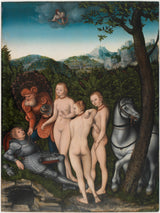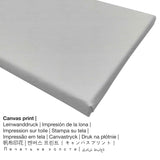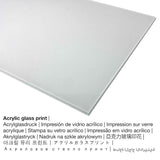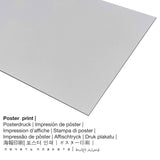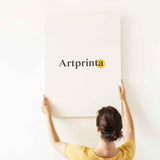Lucas Cranach the Elder, 1527 - Ikpe nke Paris - ọmarịcha nka
Ụtụ gụnyere. Mbupu gbakọrọ na ndenye ọpụpụ.
Onyinye ngwaahịa
The classic art painting "The judgement of Paris" was made by the nwoke onye na-ese ihe Lucas Cranach Onye Okenye n’afọ 1527. E ji nha ya see nke mbụ: 38 x 50,5 cm. Oil on panel was used by the artist as the technique for the work of art. Besides, the work of art belongs to the Statens Museum maka Kunst (National Gallery nke Denmark)'s nchịkọta nka dijitalụ na Copenhagen, Denmark. Site n'ikike nke: National Gallery nke Denmark (public domain license).The creditline of the artpiece is the following: . Moreover, alignment is in portrait format ya na oke nke 3: 4, nke pụtara na ogologo bụ 25% mkpụmkpụ karịa obosara. The painter Lucas Cranach the Elder was a European artist, whose art style can be attributed primarily to Northern Renaissance. The painter lived for a total of 81 years and was born in the year 1472 in Kronach, Bavaria, Germany and died in the year 1553.
Họrọ nhọrọ ihe ngwaahịa
Maka mbipụta nka ọ bụla anyị na-enye ihe dị iche iche & nha dị iche iche. Ị nwere ike ịhọrọ n'ime nhọrọ nhazi ngwaahịa ndị a:
- Ihe odide acrylic glass: The print on acrylic glass, often denoted as a UV print on plexiglass, will convert your favorite original work of art into lovely décor. In addition to that, it forms a distinct alternative option to canvas or aluminium dibond art prints. Your favorite artwork is being custom-made with the help of modern UV print technology. This creates impressive, rich color hues. With an acrylic glass art print contrasts as well as small artwork details become identifiable thanks to the delicate gradation.
- Poster (akwa akwa akwa): Our poster print is a printed canvas with a slightly rough finish on the surface, which reminds the original work of art. A poster print is best suited for placing your art copy using a personal frame. Please note, that depending on the absolute size of the canvas poster print we add a white margin 2-6cm round about the painting in order to facilitate the framing with a custom frame.
- Mbipụta kanvas: A UV printed canvas mounted on a wooden frame. Your printed canvas of this artwork will give you the chance to transform your into a large artwork like you would see in a gallery. The great advantage of canvas prints is that they are relatively low in weight, which implies that it is easy to hang up your Canvas print without the support of additional wall-mounts. Therefore, canvas prints are suited for all types of walls.
- Mbipụta ọla (aluminium dibbond): An Aluminium Dibond print is a print material with a true effect of depth - for a modern impression and non-reflective surface structure. The Direct Print on Aluminum Dibond is the excellent introduction to fine art prints with aluminum. For the Aluminium Dibond option, we print your selected artwork onto the surface of the aluminum material. The direct print on aluminium is the most popular entry-level product and is a contemporary way to display fine art reproductions, as it puts 100% of the viewer’s attention on the artwork.
Ozi dị mkpa: We try the best we can to describe our art products as accurately as we can and to display them visually. At the same time, the tone of the printed materials, as well as the print result might diverge to a certain extent from the image on your device's screen. Depending on the screen settings and the quality of the surface, color pigments can unfortunately not be printed as exactly as the digital version shown here. Given that all art prints are printed and processed by hand, there might as well be slight discrepancies in the motif's exact position and the size.
Banyere ihe a
| Bipụta ngwaahịa: | ọmarịcha nka |
| Usoro mmeghari: | dijitalụ mmeputakwa |
| Production usoro: | Mbipụta UV ozugbo (mbipụta dijitalụ) |
| Production: | emere na Germany |
| Stockdị ngwaahịa: | mmepụta ihe na-achọ |
| A na-atụ aro iji ngwaahịa eme ihe: | nka mgbidi, foto mgbidi |
| Nhazi nka nka: | usoro eserese |
| Oke akụkụ onyonyo: | ogologo ruo obosara 3: 4 |
| Mmetụta akụkụ: | ogologo bụ 25% mkpụmkpụ karịa obosara |
| Ụdị ihe dị iche iche: | Mpempe iko acrylic (nke nwere ezigbo mkpuchi iko), mbipụta ọla (aluminium dibond), mbipụta akwụkwọ mmado (akwụkwọ kwaaji), mbipụta kwaaji. |
| Nhọrọ nke Canvas Mbipụta (akwa akwa na etiti ihe ndọtị): | 30x40cm - 12x16", 60x80cm - 24x31", 90x120cm - 35x47", 120x160cm - 47x63" |
| Mpempe iko acrylic (nwere ezigbo mkpuchi iko) nha dị iche iche: | 30x40cm - 12x16", 60x80cm - 24x31", 90x120cm - 35x47", 120x160cm - 47x63" |
| Nhọrọ nke mbipụta akwụkwọ mmado (akwụkwọ kwaaji): | 30x40cm - 12x16", 60x80cm - 24x31", 90x120cm - 35x47" |
| Nhọrọ Dibond (ihe alumnium) nhọrọ: | 30x40cm - 12x16", 60x80cm - 24x31", 90x120cm - 35x47" |
| Nhazi mbipụta nka: | agunyeghi |
Nkọwa ihe osise
| Aha nka: | "The judgement of Paris" |
| Nhazi: | sere |
| Otu sara mbara: | nka ochie |
| Narị afọ nka: | 16th narị afọ |
| Afọ okike: | 1527 |
| Ogologo afọ nka nka: | ihe karịrị afọ 490 |
| Ihe osise izizi: | mmanụ na panel |
| Akụkụ nke ihe osise izizi: | 38 x 50,5 cm |
| Ụlọ ihe ngosi nka / mkpokọta: | Statens Museum maka Kunst (National Gallery nke Denmark) |
| Ebe ngosi nka: | Copenhagen, Denmark |
| Ebe nrụọrụ weebụ ihe ngosi nka: | Statens Museum maka Kunst (National Gallery nke Denmark) |
| License: | ngalaba ọha |
| Site n'aka: | National Gallery nke Denmark |
Ose okwu
| Aha onye nka: | Lucas Cranach Onye Okenye |
| A makwaara dịka: | Lucas Cranach the Elder, Cranach Muller, Lucas Müller genannt Cranach, Lucas Cranach D. Ältere, Cranach des Älteren, Lucas I Cranach, Lukas Cranach d. Ae., Cranach Lucas van, L. Cranache, Lucas Cranach der Ältere, Cronach, l. cranach d. aelt., Luc. Cronach, Lukas Cranach, Luca Kranack, Cranach Lucas the elder, Lucas de Cranach le père, Lucas Müller genannt Cranach, Cranach the Elder Lucas, Cranach Lukas d. A., L. Kranach, Lucas Cranach d.Äe., Lucas Kranack, Luc Kranach, cranach lucas d. ae., Sunder Lucas, L. Kranachen, Cranach Luc., Lucas Cranch, lucas cranach d. aelt., Cranach Lukas Der Ältere, l. cranach der altere, Cranach Lukas d.Äe., Lucas Cranack, L. Cranaccio, Kronach Lucas, Cranach Lukas d. Ae., Luckas Cranach d. Ä., Lucas (The Elder) Cranach, Lucas Cranik, L. Cranach, Sonder Lucas, cranach lukas d. ae., Cranach Lucas d. Ält., cranach the elder lucas, cranach lucas der altere, Cranach Sunder, Kranakh Luka, Lucas Kranich, Luc. Kranachen, Lucas Cranach, cranach lucas d. a., Cranach Lucas Der Ältere, Lucas Kranach, von Lucas Müller genannt Cranach dem Alten, von Lucas Kranach dem ältern, Cranach Lukas, Kranach, l. cranach d. alt., Cranack, Lucas de Cronach, Cranach d. Ä. Lucas, Lucas de Cranach, lucas cranach d. alt., Lukas Cranach D. Ä., Cranaccio, Lucas Kraen, Lucas Cranache, älteren Lucas Cranach, L. von Cranach, lucas cranach d.Ä.lt, cranach lucas the elder, cranach lucas d. alt., lukas cranach der altere, lucas cranach d. a., Lucas Krane, Luc Cranach, L. Cranack, Lucas Cranaccio, Cranach, קראנאך לוקאס האב, cranach lucas d.a., Lucas Müller genannt Sunders, Muller Lucas, Lucas van Cranach, Lukas Cranach d.Ä., Luc. Cranach, Cranach Lukas d. Ä., Luca Kranach, Cranach Lucas I, Kranach Lukas, Lucas Cranach d.Ä., Lucas Granach, Cranach Lucas, Luca Cranch, Moller Lucas, L. Cranac, L. Kronach, Cranach Lucas van Germ., Luca Cranach, Cranak, Lukas Cranach dem Aeltern, Luc. Kranach, Lucas Kranachen, lucas cranach d. ae., Lucius Branach, Maler Lucas, Cranach Lucas (The Elder) |
| okike nke onye nka: | nwoke |
| Obodo onye nka: | German |
| Ọrụ onye na-ese ihe: | onye na-ese ihe |
| Country: | Germany |
| Nhazi nke onye nka: | nna ukwu ochie |
| Ụdị nka: | Northern Renaissance |
| Nwụrụ anwụ: | 81 afọ |
| Afọ ọmụmụ: | 1472 |
| Amụrụ na (ebe): | Kronach, Bavaria, Germany |
| Afọ ọnwụ: | 1553 |
| Nwụrụ na (ebe): | Weimar, Thuringia, Germany |
Enwere ikike nwebiisinka © | Artprinta (www.artprinta.com)
(© - nke Statens Museum for Kunst (National Gallery of Denmark) - Statens Museum maka Kunst (National Gallery nke Denmark))
According to the myth, Prince Paris was asked by Mercury to choose which of the three goddesses, Juno, Minerva or Venus, was the most beautiful.
Paris is here seen lying on the left, having just been awakened by Mercury after a dream, and the three goddesses are standing naked before him. Each of them has individually promised him a gift if the choice falls on her. Juno has promised him power and Minerva success as a warrior, while Venus promised him the most beautiful woman on earth.
The wrong choice The choice has not yet been made in the picture, but we know from the myth that Paris chose Venus and thus physical love. This had terrible consequences. Among the things resulting from it was the Trojan War. So Prince Paris made the wrong choice.
The motif One of the goddesses is staring at the viewer. She is forcing him to make the choice that has not yet been made in the picture and which therefore remains open. The viewer, who of course knows the outcome of the story, is thus encouraged to make a different choice from the wrong one made by Paris. The goddess’ gaze thus emphasises the situation of choice.

